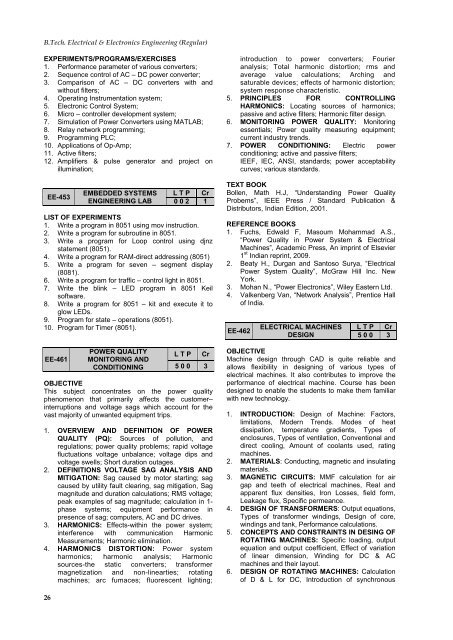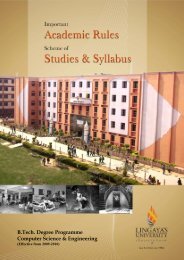Electrical and Electronics - Lingaya's University
Electrical and Electronics - Lingaya's University
Electrical and Electronics - Lingaya's University
You also want an ePaper? Increase the reach of your titles
YUMPU automatically turns print PDFs into web optimized ePapers that Google loves.
B.Tech. <strong>Electrical</strong> & <strong>Electronics</strong> Engineering (Regular)EXPERIMENTS/PROGRAMS/EXERCISES1. Performance parameter of various converters;2. Sequence control of AC – DC power converter;3. Comparison of AC – DC converters with <strong>and</strong>without filters;4. Operating Instrumentation system;5. Electronic Control System;6. Micro – controller development system;7. Simulation of Power Converters using MATLAB;8. Relay network programming;9. Programming PLC;10. Applications of Op-Amp;11. Active filters;12. Amplifiers & pulse generator <strong>and</strong> project onillumination;EE-453EMBEDDED SYSTEMSENGINEERING LABL T P Cr0 0 2 1LIST OF EXPERIMENTS1. Write a program in 8051 using mov instruction.2. Write a program for subroutine in 8051.3. Write a program for Loop control using djnzstatement (8051).4. Write a program for RAM-direct addressing (8051)5. Write a program for seven – segment display(8081).6. Write a program for traffic – control light in 8051.7. Write the blink – LED program in 8051 Keilsoftware.8. Write a program for 8051 – kit <strong>and</strong> execute it toglow LEDs.9. Program for state – operations (8051).10. Program for Timer (8051).EE-461POWER QUALITYMONITORING ANDCONDITIONINGL T PCr5 0 0 3OBJECTIVEThis subject concentrates on the power qualityphenomenon that primarily affects the customer–interruptions <strong>and</strong> voltage sags which account for thevast majority of unwanted equipment trips.1. OVERVIEW AND DEFINITION OF POWERQUALITY (PQ): Sources of pollution, <strong>and</strong>regulations; power quality problems; rapid voltagefluctuations voltage unbalance; voltage dips <strong>and</strong>voltage swells; Short duration outages.2. DEFINITIONS VOLTAGE SAG ANALYSIS ANDMITIGATION: Sag caused by motor starting; sagcaused by utility fault clearing, sag mitigation, Sagmagnitude <strong>and</strong> duration calculations; RMS voltage;peak examples of sag magnitude; calculation in 1-phase systems; equipment performance inpresence of sag; computers, AC <strong>and</strong> DC drives.3. HARMONICS: Effects-within the power system;interference with communication HarmonicMeasurements; Harmonic elimination.4. HARMONICS DISTORTION: Power systemharmonics; harmonic analysis; Harmonicsources-the static converters; transformermagnetization <strong>and</strong> non-linearties; rotatingmachines; arc fumaces; fluorescent lighting;introduction to power converters; Fourieranalysis; Total harmonic distortion; rms <strong>and</strong>average value calculations; Arching <strong>and</strong>saturable devices; effects of harmonic distortion;system response characteristic.5. PRINCIPLES FOR CONTROLLINGHARMONICS: Locating sources of harmonics;passive <strong>and</strong> active filters; Harmonic filter design.6. MONITORING POWER QUALITY: Monitoringessentials; Power quality measuring equipment;current industry trends.7. POWER CONDITIONING: Electric powerconditioning; active <strong>and</strong> passive filters;IEEF, IEC, ANSI, st<strong>and</strong>ards; power acceptabilitycurves; various st<strong>and</strong>ards.TEXT BOOKBollen, Math H.J, ―Underst<strong>and</strong>ing Power QualityProbems‖, IEEE Press / St<strong>and</strong>ard Publication &Distributors, Indian Edition, 2001.REFERENCE BOOKS1. Fuchs, Edwald F, Masoum Mohammad A.S.,―Power Quality in Power System & <strong>Electrical</strong>Machines‖, Academic Press, An imprint of Elsevier1 st Indian reprint, 2009.2. Beaty H., Durgan <strong>and</strong> Santoso Surya, ―<strong>Electrical</strong>Power System Quality‖, McGraw Hill Inc. NewYork.3. Mohan N., ―Power <strong>Electronics</strong>‖, Wiley Eastern Ltd.4. Valkenberg Van, ―Network Analysis‖, Prentice Hallof India.EE-462ELECTRICAL MACHINESDESIGNL T P Cr5 0 0 3OBJECTIVEMachine design through CAD is quite reliable <strong>and</strong>allows flexibility in designing of various types ofelectrical machines. It also contributes to improve theperformance of electrical machine. Course has beendesigned to enable the students to make them familiarwith new technology.1. INTRODUCTION: Design of Machine: Factors,limitations, Modern Trends. Modes of heatdissipation, temperature gradients, Types ofenclosures, Types of ventilation, Conventional <strong>and</strong>direct cooling, Amount of coolants used, ratingmachines.2. MATERIALS: Conducting, magnetic <strong>and</strong> insulatingmaterials.3. MAGNETIC CIRCUITS: MMF calculation for airgap <strong>and</strong> teeth of electrical machines, Real <strong>and</strong>apparent flux densities, Iron Losses, field form,Leakage flux, Specific permeance.4. DESIGN OF TRANSFORMERS: Output equations,Types of transformer windings, Design of core,windings <strong>and</strong> tank, Performance calculations.5. CONCEPTS AND CONSTRAINTS IN DESING OFROTATING MACHINES: Specific loading, outputequation <strong>and</strong> output coefficient, Effect of variationof linear dimension, Winding for DC & ACmachines <strong>and</strong> their layout.6. DESIGN OF ROTATING MACHINES: Calculationof D & L for DC, Introduction of synchronous26
















